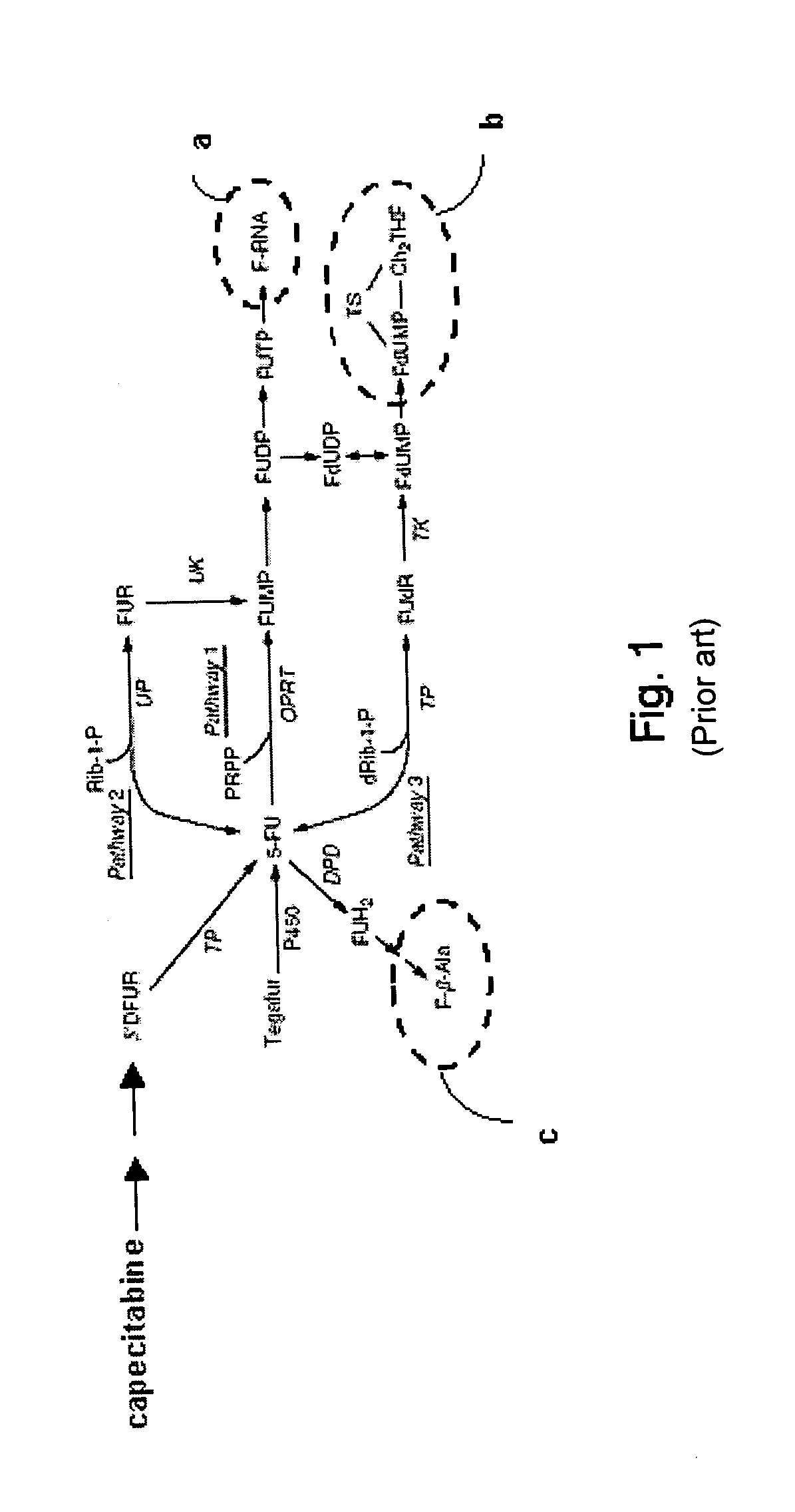Methods, compositions, and kits for organ protection during systemic anticancer therapy
a systemic anticancer and organ protection technology, applied in the direction of antinoxious agents, drug compositions, biocides, etc., can solve the problems of limiting clinical usefulness, disfavored oral administration of 5-fu, and inability to determine the extent to which any of these pathways predominate in human tumors
- Summary
- Abstract
- Description
- Claims
- Application Information
AI Technical Summary
Benefits of technology
Problems solved by technology
Method used
Image
Examples
example 1
[0159]The theoretical systemic exposure to uracil from the topical application of a 1% w / w uracil ointment to the hands and feet can be crudely estimated as follows.
[0160]Application of 0.1 gm of a 1% (w / w) uracil ointment to the hands and feet four times a day represents an exposure of 4–8 mg of uracil / day. The topical absorption of agents through intact skin can be on the order of 1%, leading to a systemic absorption of 40–80 μg / day. This contrasts with exposure of about 1200 mg / day of uracil in UFT. Thus, the mean systemic uracil exposure with uracil ointment averages about 0.00005 (0.005%) that of UFT.
[0161]At the skin surface, however, and in the underlying skin, the concentration of uracil should be about 10 mg / ml. The average plasma 5-FU concentration is usefully estimated at 0.5 μg / ml. Thus, topical administration of uracil ointment theoretically establishes a local concentration of uracil that is approximately 2000-fold that of 5-FU at the skin, with a systemic dose only 0....
example 2
[0162]A 48 year old female patient exhibited metastatic breast cancer. She had refused mastectomy and had previously failed adriamycin and cytoxan, weekly taxol, and weekly navelbine. She was then placed on Xeloda® together with 1% uracil ointment applied to the hands and feet. The 1% uracil ointment was used starting with cycle 5 of treatment with Xeloda®.
[0163]Table 1 below summarizes results on this patient.
[0164]
TABLE 1Courseq3wk12345678Xeloda1250SameD / C10001250SameSameSamedosemg / aftermg / mg / m214 / 21m24m2bid ×daysbid ×daysbid ×141414Taxotere++++++++75 mg / m2Marker12 ×8 ×7 × 77 ×9 × 98.5 ×8 ×8.5 ×tumor1287progres-8.588.5size cm-sion onprior tolower doserxXeloda ®1%0000++++uracilointmentHand-ND*ND++++++0000footsyndrome*ND: Not described
[0165]The 1% uracil ointment allowed a re-escalation of the dose of Xeloda® with anti-tumor activity at the higher dose of Xeloda®. The 1% uracil ointment allowed a higher dose of Xeloda® to be administered with improved anti-cancer efficacy (compare c...
example 3
[0166]Another patient, a 68 year old white female diagnosed with metastatic colon cancer, was treated with Xeloda® and thalidomide. Hand-Foot Syndrome developed. Complete reversal of the syndrome occurred after topical treatment with a 1% uracil ointment. The efficacy of the Xeloda® and thalidomide treatment was unaffected by the concurrent use of 0.1 g 1% uracil ointment four times a day. There were no dose reductions of chemotherapy or treatment delays.
PUM
 Login to View More
Login to View More Abstract
Description
Claims
Application Information
 Login to View More
Login to View More - R&D
- Intellectual Property
- Life Sciences
- Materials
- Tech Scout
- Unparalleled Data Quality
- Higher Quality Content
- 60% Fewer Hallucinations
Browse by: Latest US Patents, China's latest patents, Technical Efficacy Thesaurus, Application Domain, Technology Topic, Popular Technical Reports.
© 2025 PatSnap. All rights reserved.Legal|Privacy policy|Modern Slavery Act Transparency Statement|Sitemap|About US| Contact US: help@patsnap.com

